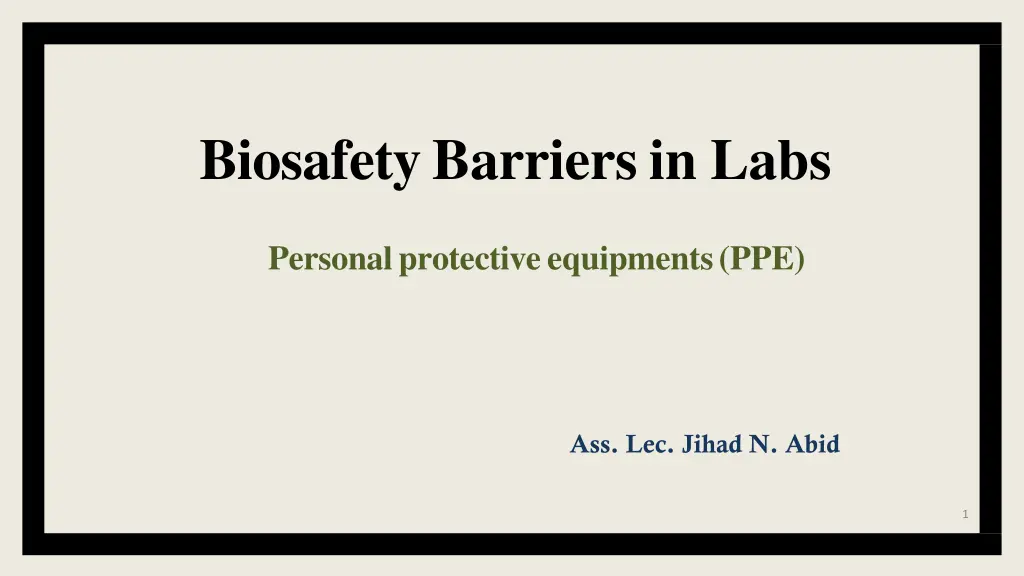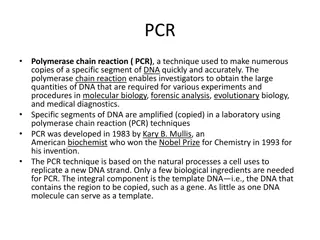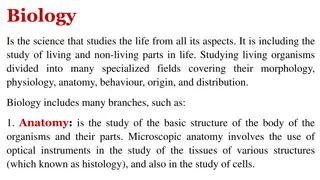
Lab Biosafety Barriers and Personal Protective Equipments
Discover the essential biosafety barriers in labs, including primary and secondary barriers, physical barriers, and specialized clothing. Learn about the importance of PPE, equipment for lab workers, and structural aspects for a safer working environment against infections.
Download Presentation

Please find below an Image/Link to download the presentation.
The content on the website is provided AS IS for your information and personal use only. It may not be sold, licensed, or shared on other websites without obtaining consent from the author. If you encounter any issues during the download, it is possible that the publisher has removed the file from their server.
You are allowed to download the files provided on this website for personal or commercial use, subject to the condition that they are used lawfully. All files are the property of their respective owners.
The content on the website is provided AS IS for your information and personal use only. It may not be sold, licensed, or shared on other websites without obtaining consent from the author.
E N D
Presentation Transcript
Biosafety Barriers in Labs Personal protective equipments (PPE) Ass. Lec. Jihad N. Abid 1
PRIMARY BARRIERS (control hazard at source) BSC SECONDARY BARRIERS (structure surrounding primary barrier) 3
Physical barriers or personal protective equipments (PPE) for lab worker Gloves, masks, Goggles, aprons, suits, special breathing apparatuses Primary containment equipment BSC Sealed centrifuge 3
Secondary barriers: structural aspects of the laboratory that make working environment safer against infection such as Sinks for hand washing, Special containment areas, Special air ventilation patterns and Sterilization equipments. HEPA filters (high efficiency particulate air) Liquid effluent treatment Sealed laboratory walls and floors 4
Practice and procedures Standard practices Special practices and considerations Safety equipment Facility design and construction Increasing levels of protection 5
Primary containment barrier Minimize exposure to hazard Engineering controls / equipment PPE Biological safety cabinets 6
Specialized clothing / equipment worn by an employee for protection against infectious materials Provides protection from (bio) hazards It is removable and/or disposable (prevents contamination of community and environment) Must be worn when handling hazards (including infectious materials) Must be removed before leaving the work place
TYPES OF PPE Body protection Head Protection: o Protect hair and scalp from contamination o Hair covers Foot Protection: o Protect entire foot o Disposable shoe covers (additional layer of protection) o Rubber boots o Dedicated lab shoes o Non-slip footwear Additional Body Protection (based on risk assessment): o Disposable sleeve covers o Scrubs
Lab Coats and gowns used to protect from infectious fluids Don t wear lab coats outside of the lab or take them home Cuffed sleeves can protect the wrists and lower arms 14
Face protection Worn when potential risk for splashing / splattering Prevents splashing of infectious materials into eyes, nose, and/or mouth Protects mucous membranes from exposure Examples: Face shield Surgical mask o Indirectly vented safety goggles o o
Hand protection Reduces potential of hand contamination Reduces risks associated with ingestion and skin contact Gloves are made of different materials Latex, nitrile, vinyl, polyethylene, etc. Should be selected for specific activity and hazard Suitability of glove needs to be verified prior to handling infectious materials
Gloves Avoid latex gloves (may cause allergies) Do not reuse gloves Do not wear gloves outside of the laboratory Wash hands after removing gloves 12
Respiratory Protection Two types: air supplying and air purifying Full face, half face, PAPR (Powered Air Purifying Respirator) Special considerations: fit testing; facial hair; comfort; care and maintenance 13
Respiratory Protection N95 respirators N100 respirators 14
PPE should be carefully inspected for damages/breaches prior to donning PPE Change gloves as needed Gloves become means of spreading infectious materials when contaminated Doffing PPE must be performed carefully to minimize contamination Doffing PPE needs to be immediately followed by handwashing Proper disposal of PPE as biohazard waste Proper decontamination and laundering of reusable PPE Proper use/removal
Fume Hood Laminar Flow Cabinet (LFC) Biohazard Safety Cabinet (BSC) 17

![❤[READ]❤ Cosmic Biology: How Life Could Evolve on Other Worlds (Springer Praxis](/thumb/21556/read-cosmic-biology-how-life-could-evolve-on-other-worlds-springer-praxis.jpg)




















